Featured Comment
Finally, the perfect teriyaki recipe! It’s AUTHENTIC, simple teriyaki without any extraneous ingredients and with the perfect ratio. It’s absolutely delicious! Thank you so much, we’ve made this many times now and love it.
★★★★★
– Laura
Sushi, ramen, tempura, miso soup, yakitori… you’ve probably heard them all. But teriyaki chicken holds its own, with less fuss and just one pan.
This recipe shows Japanese authentic glaze method. Once you know it, busy weeknights feel a lot lighter.

Authentic Teriyak Chicken
Recipe Snapshot
- What is it? Authentic Crispy-Skin Teriyaki Chicken Thighs
- Flavor profile: Sweet, Savory, Umami-Rich
- Why you’ll love this recipe: You’ll love how this recipe delivers a homemade Japanese favorite in under 30 minutes without sacrificing flavor or requiring tricky steps.
- Must-haves: (ingredients or tools)
- Skill Level: Easy
- Suitable for Meal Prep? Partially with trade-offs.
Summarize & Save this content on:

What is Japanese Teriyaki Chicken?
Teriyaki chicken (照り焼きチキン) is a Japanese classic where chicken is pan-cooked in a glossy glaze made from just four core ingredients: soy sauce, sake, mirin, and sugar. No marinating required for the Japanese method. Just simmer the sauce until it thickens and coats the chicken beautifully. That’s the “teri (照り),” or shine, that makes teriyaki so tempting.
In Japan, yellowtail teriyaki is the most traditional version, but chicken has become a family favorite for its juicy, satisfying bite. You’ll also find variations like teriyaki salmon for a lighter option or even playful twists like teriyaki pizza.
And if you don’t have sake or mirin, no worries! You can still get delicious result with my mock teriyaki recipe without using sake and mirin. For more ideas, check out my collection of teriyaki dishes.
Authentic Teriyaki Chicken Ingredients
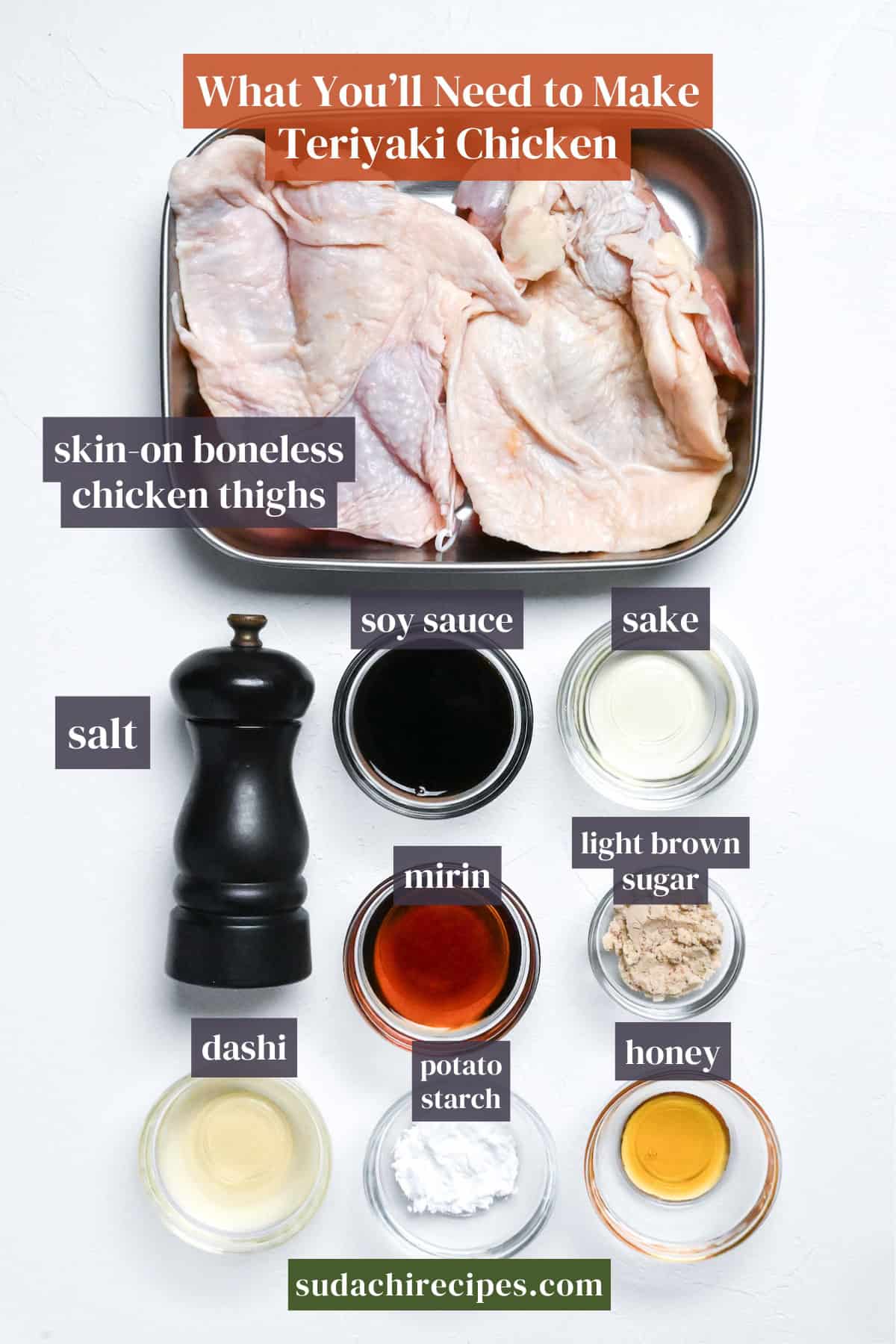
- Boneless chicken thigh: This is the classic cut for Japanese teriyaki. Prefer leaner chicken breast? Butterfly to even thickness and lightly score or pierce so it cooks fast and stays tender. The trade-off is a cleaner taste but less succulence, so don’t overcook.
- Teriyaki basics: Japanese teriyaki is a simple mix of soy sauce, mirin, sake, and sugar (2:2:2:1 golden ratio). I like swapping in honey for some of the sugar, but all in sugar works perfectly.
- Dashi Stock: If you’ve got leftover dashi from another recipe, use that. Don’t stress about making dashi from scratch or using dashi packet. Just whisk a pinch of dashi granules into warm water. You’re only using a small amount for this recipe.
Substitution Ideas
- Mirin Substitutes: Mix sugar with white wine or dry sherry for that sweet-tangy balance, or just use sugar and water for alcohol-free. Surprisingly, cola makes a great 1:1 swap thanks to its complexity.
- Sake Alternatives: White wine or dry sherry substitute fine.
- Going Alcohol-Free: Need to skip both mirin and sake? Check out my alcohol-free teriyaki chicken recipe.
- Potato Starch Substitute: Cornstarch works just as well for coating the chicken.
Have trouble finding Japanese ingredients? Check out my ultimate guide to Japanese ingredient substitutes!
How to Make My Japanese Teriyaki Chicken
If you prefer to watch the process in action, check out my YouTube video of this teriyaki chicken recipe!
i. Place boneless, skin-on chicken thighs skin-side down on a board. Make a shallow horizontal cut through the thickest parts to create a flaps, then open them so the piece is an even thickness throughout for uniform cooking and juiciness. Even thickness prevents dry edges and undercooked centers.
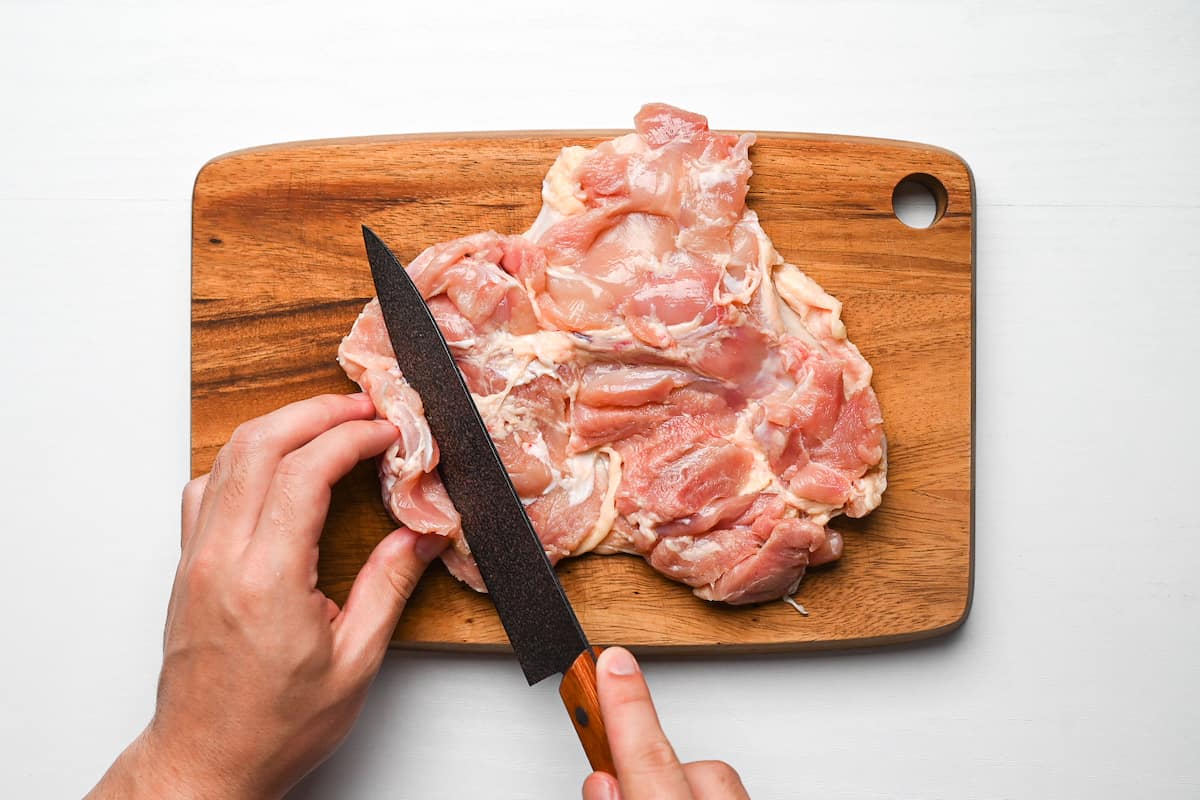
Use large bite-size pieces (3-4 cm / 1¼-1½ in). Sear skin-side pieces 3-4 minutes, flip 2 minutes, then glaze as instructed later just like I did for teriyaki chicken bowl and yakitori don. Always verify the center reaches at least 74-75℃ (165-167°F) for safety.
ii. Flip the thigh skin-side up and lightly prick the skin all over with a fork.

Those tiny fork holes let the fat render out more easily, preventing the skin from puffing up like a balloon.
iii. Pat the surface dry with paper towels. It might seem like a small detail, but moisture is the enemy of crispy skin. Plus, a dry surface helps the sauce stick better.
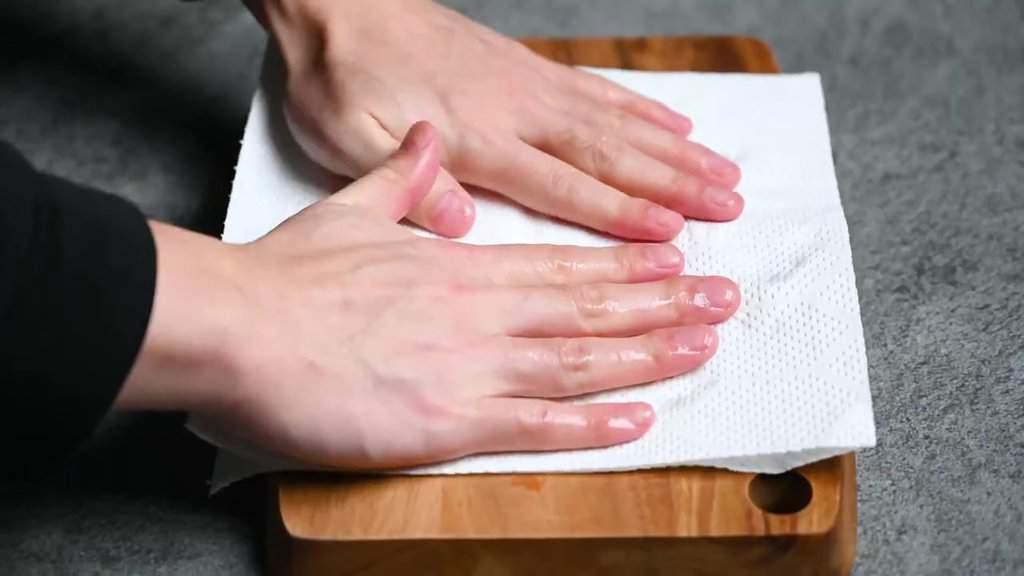
iv. Then, season both sides with a good pinch of salt and gently rub it in.
Important Note: From here, I’ll introduce two different methods: the Traditional Method, which coats both sides of the chicken with glaze, and the Extra Crispy Method, which crisps up the skin side and preserves that crunchy texture. Since there are differences in a few steps, I’ve marked the extra crispy method steps with (e) for easy reference.”
i. Sift a very thin veil of potato starch over only the flesh side, and tap off any excess. This micro-coating traps surface juices, guards the meat against harsh pan heat, and gives your glaze something to cling to.
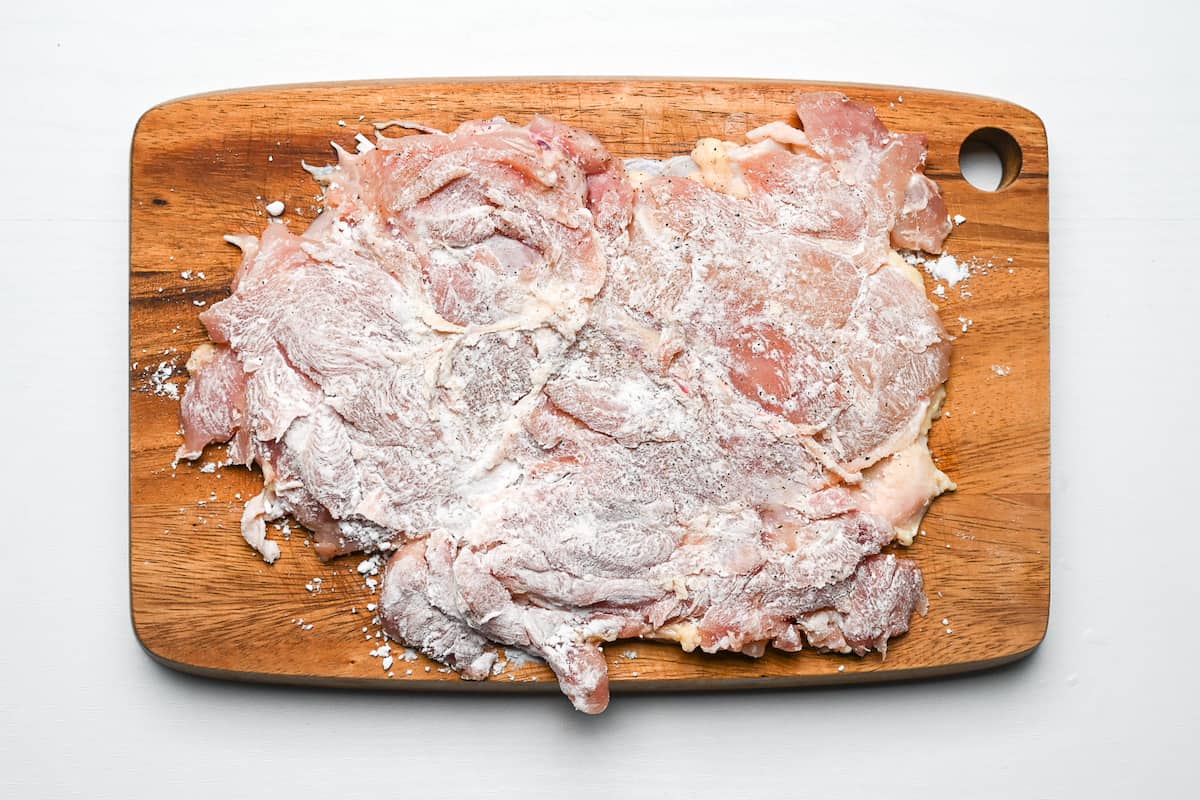
i (e). The extra-crispy method flips the script and dusts the skin side instead.

Potato starch creates more transparency and shine, perfect for teriyaki’s glossy finish. Cornstarch works too, offering slightly less gloss but more stability.
i. Heat your empty pan well. Add oil and swirl to coat, reduce the heat slightly, then place the chicken skin-side down and cook for 7 minutes without moving it.
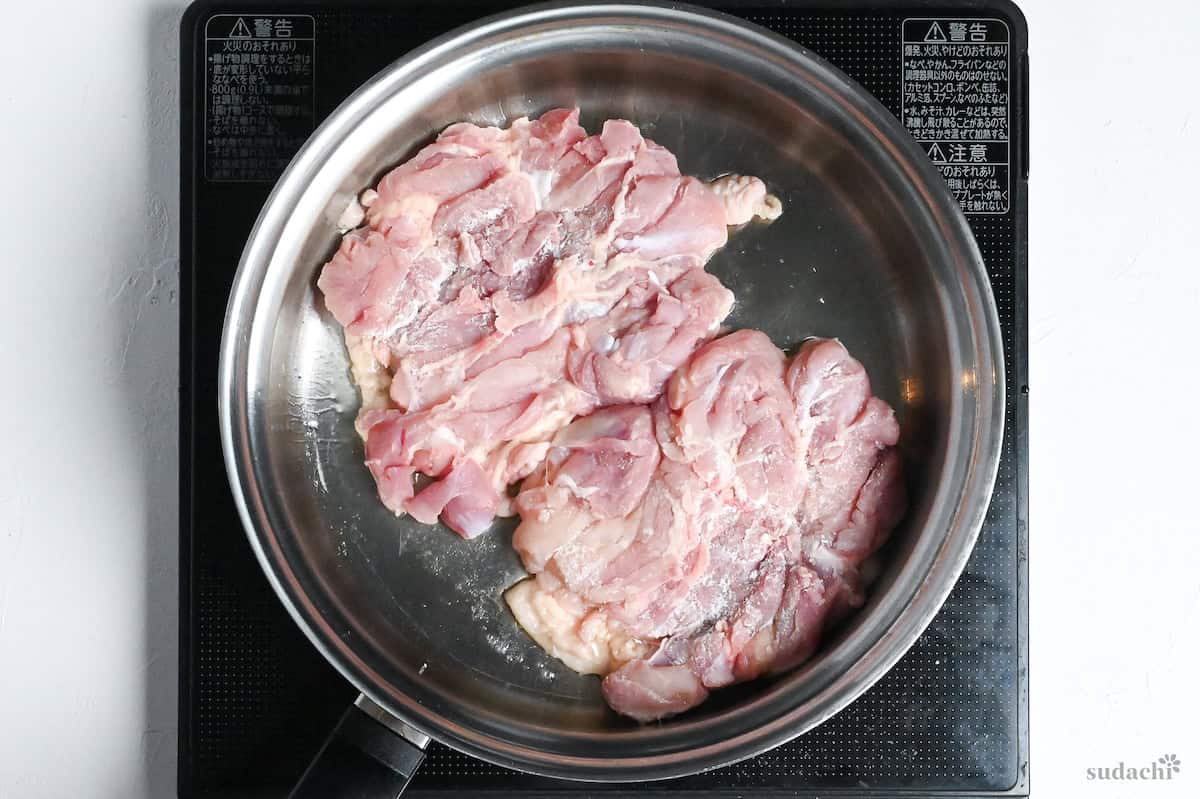
ii (e). For even crispier results, place a sheet of aluminum foil over the chicken.
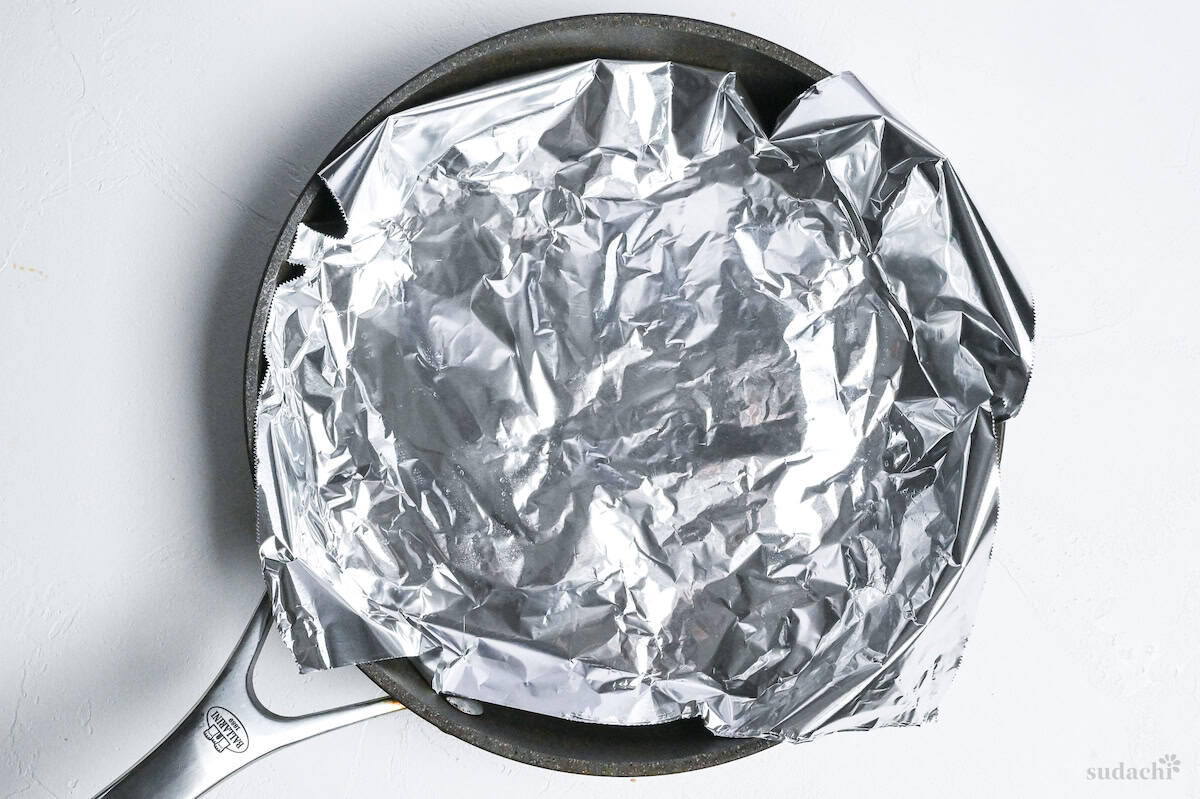
iii (e). Then set a moderately heavy, flat-bottomed object on top, like a second pan filled with water like I did for my ponzu chicken recipe. Cook for 7 minutes.
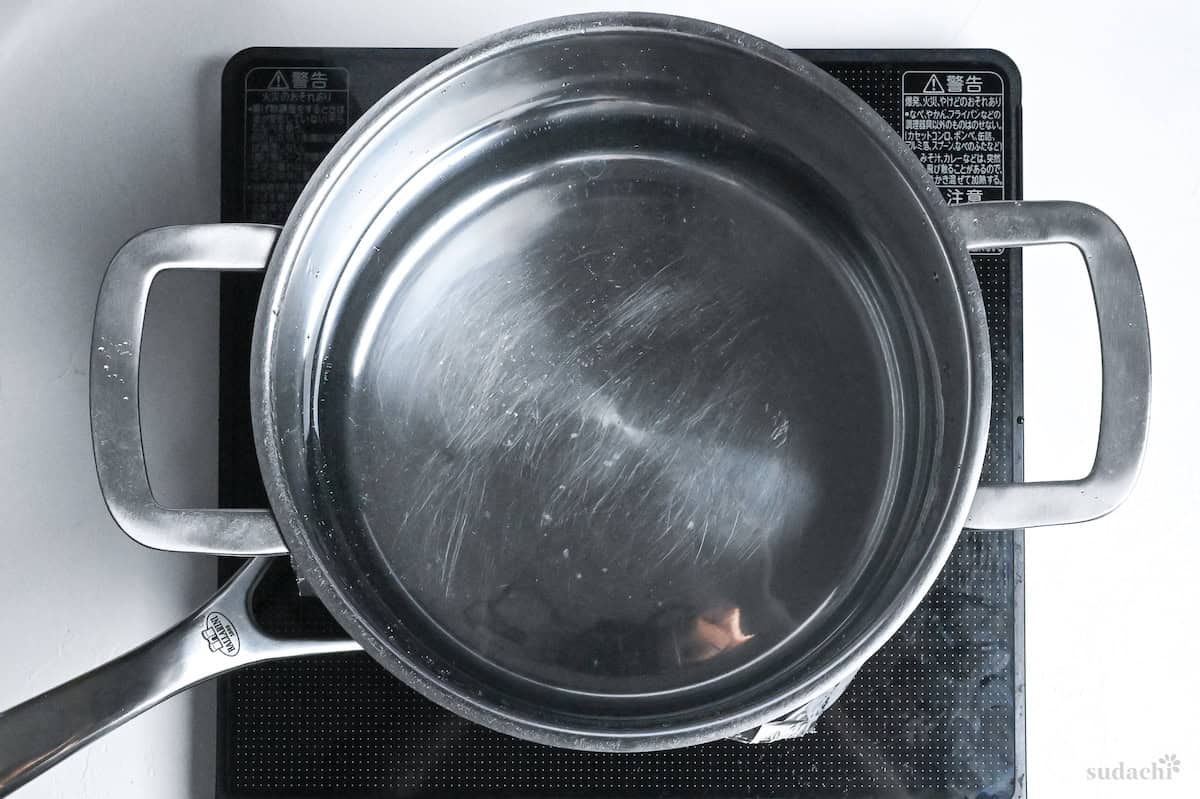
This gentle pressure eliminates air pockets, ensuring every millimeter of skin makes contact with the pan for incredibly even crisping. The weight also prevents the skin from curling up at the edges.
i. While it cooks, combine soy sauce, mirin, sake, light brown sugar, dashi stock, and honey in a small bowl. Stir until the sugar and honey dissolve so the glaze reduces smoothly later.
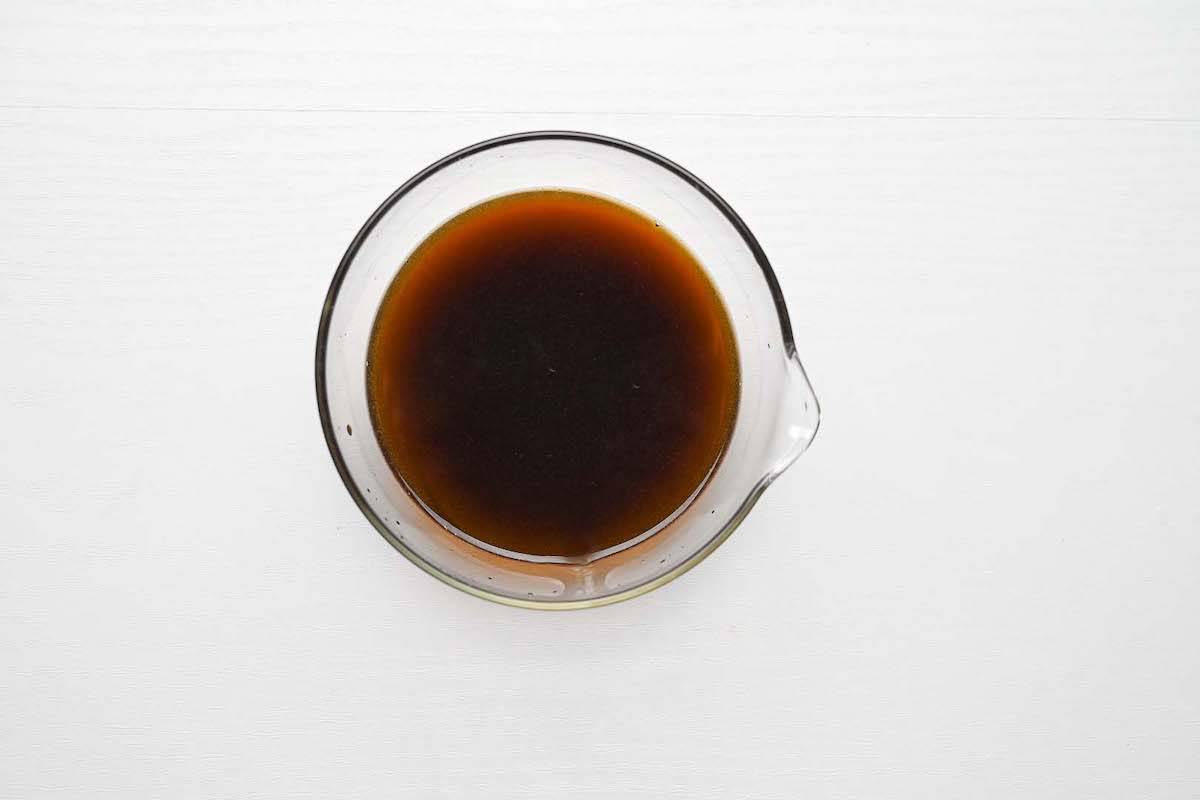
Glutamate from soy/dashi and inosinate from chicken amplify one another, boosting savoriness far beyond either alone.
i. Flip the chicken and cook the other side for 2 minutes.
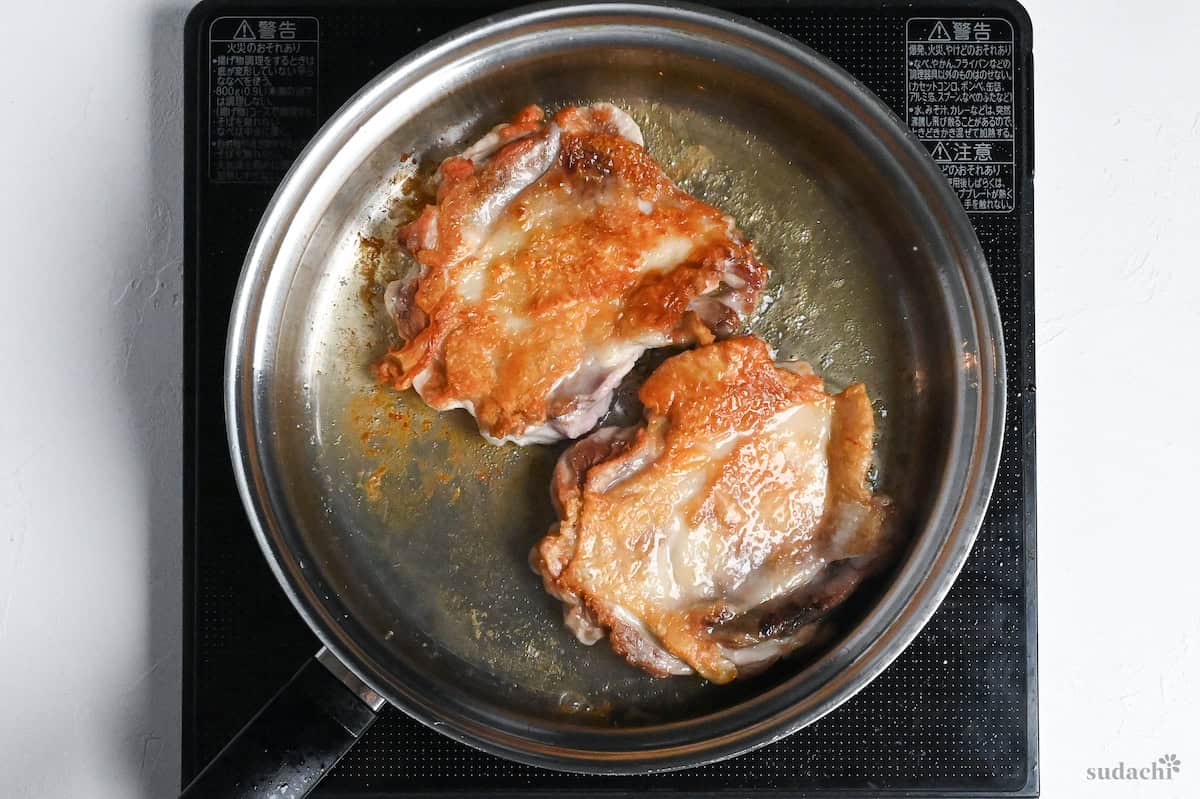
ii. Then transfer it briefly to a plate.
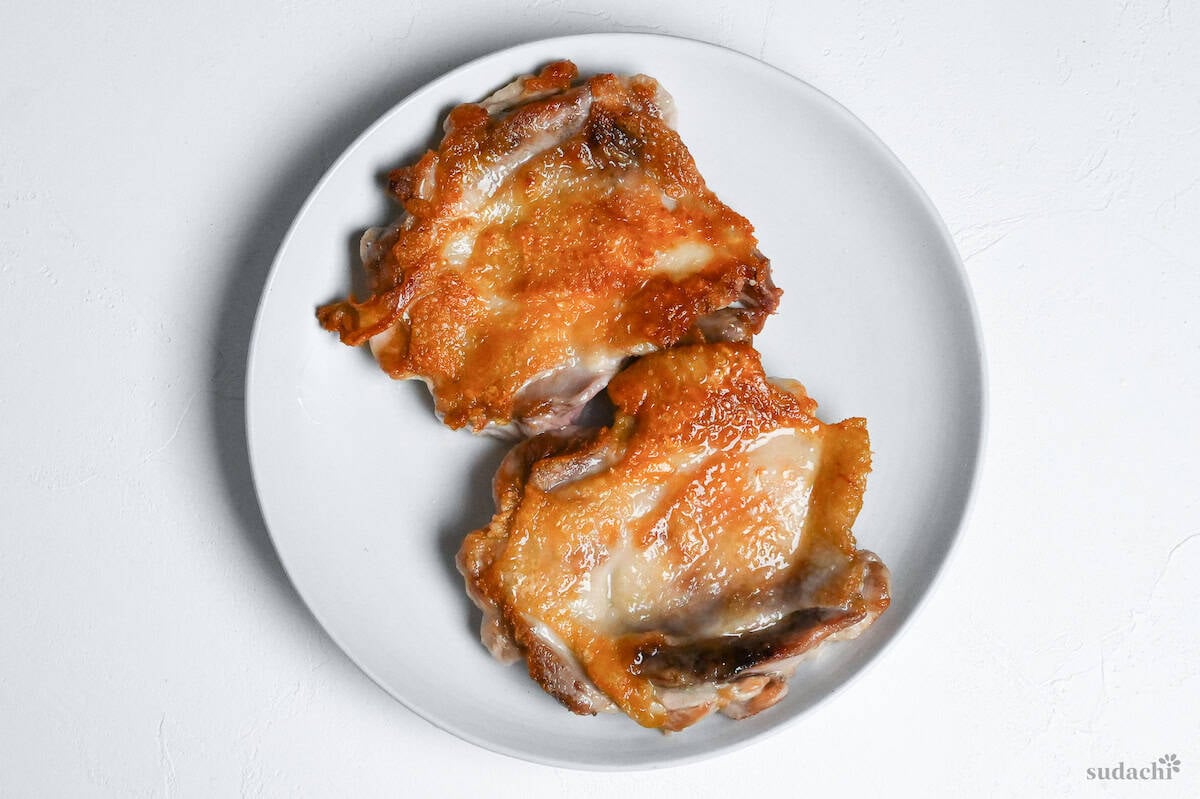
iii. Pour off all but about 1 tbsp of rendered fat into a heatproof cup to keep the glaze bright, not greasy. Save that golden chicken fat for fried rice or shoyu ramen later.
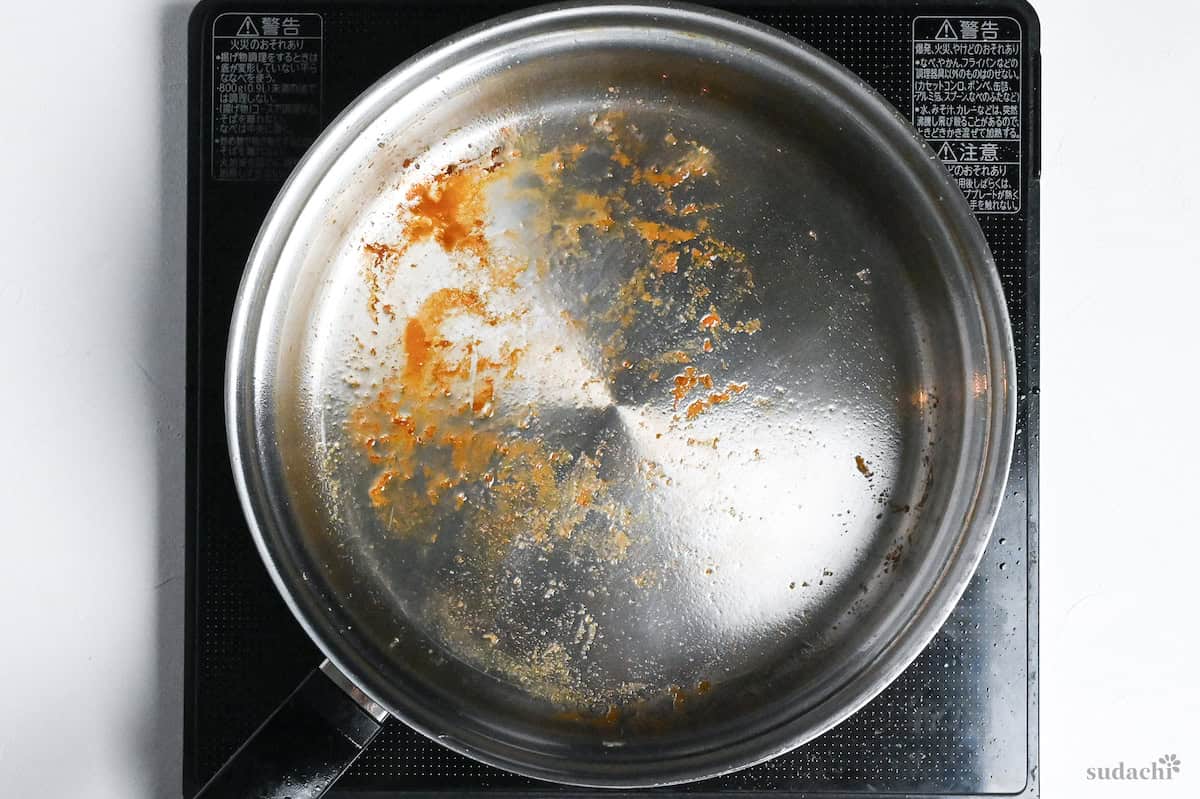
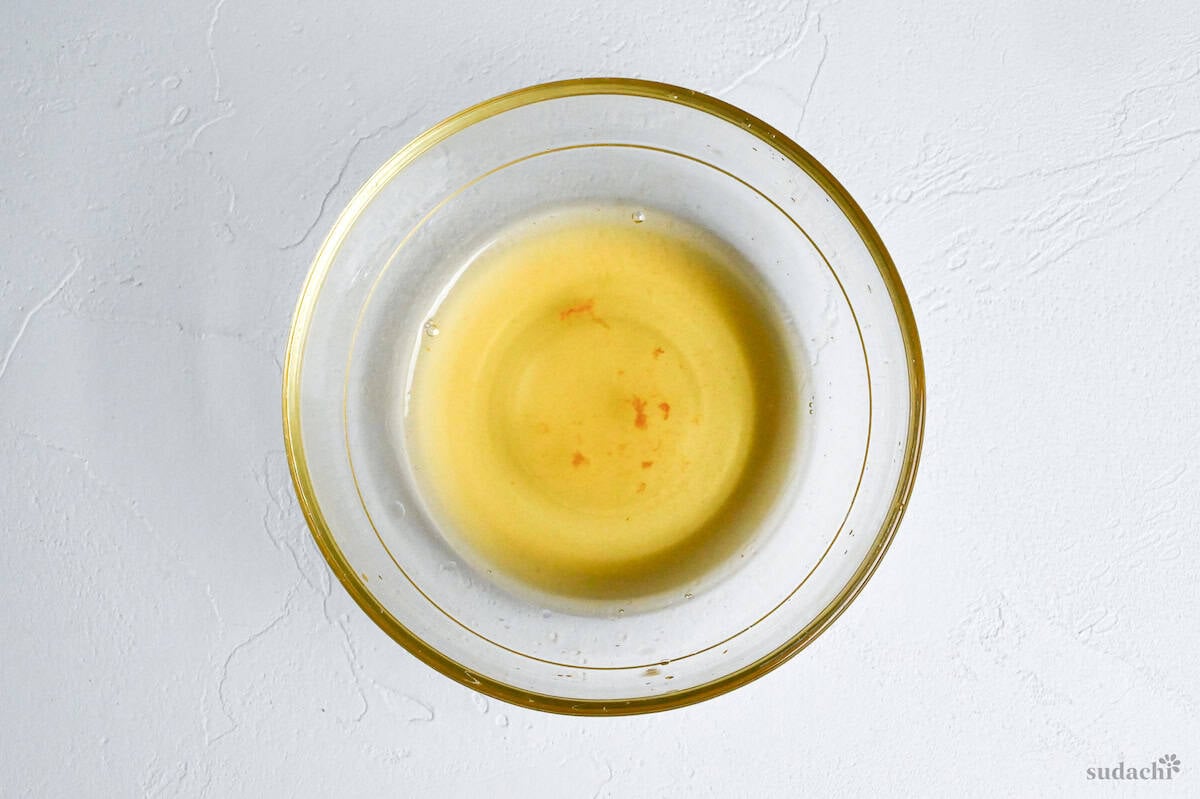
Removing excess fat improves emulsion stability and lets the glaze cling rather than separate. Deglazing dissolves the caramelized “sucs” into the sauce for depth.
iv. With the heat off, pour in the sauce and scrape up the browned bits (fond/sucs) with a spatula. Those concentrated drippings supercharge flavor.
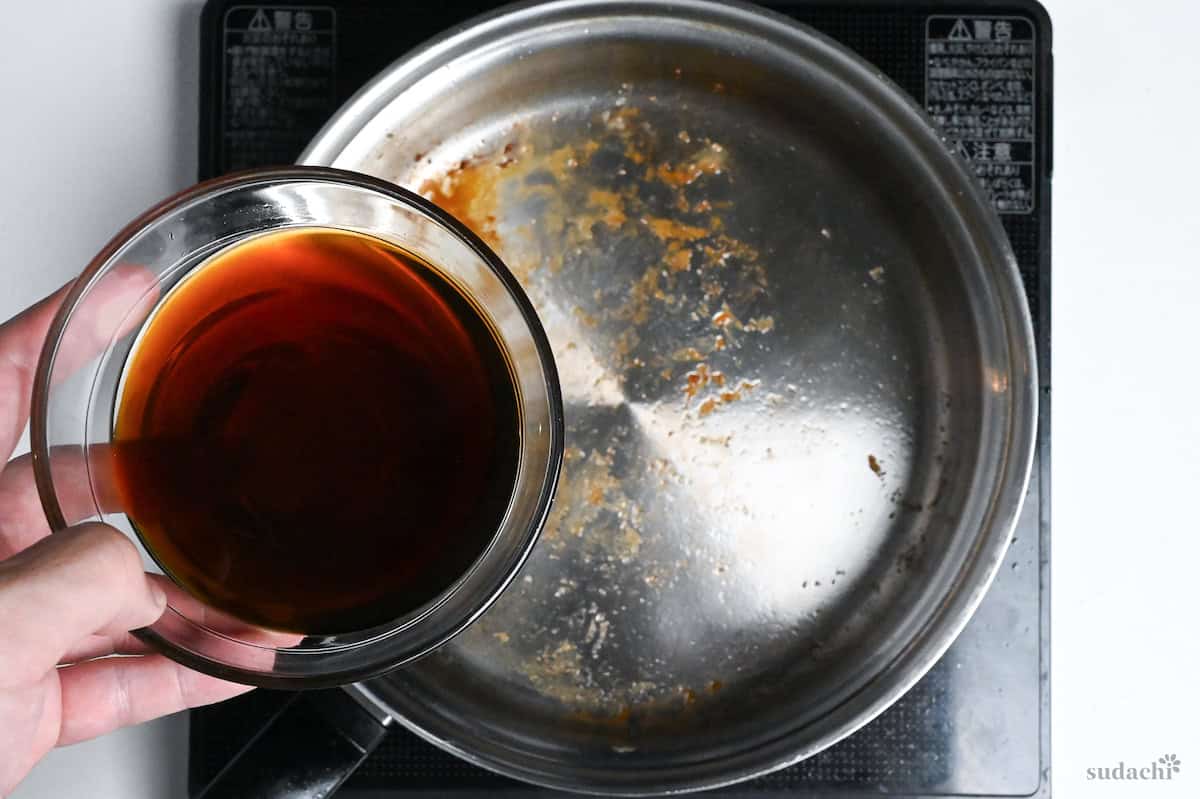
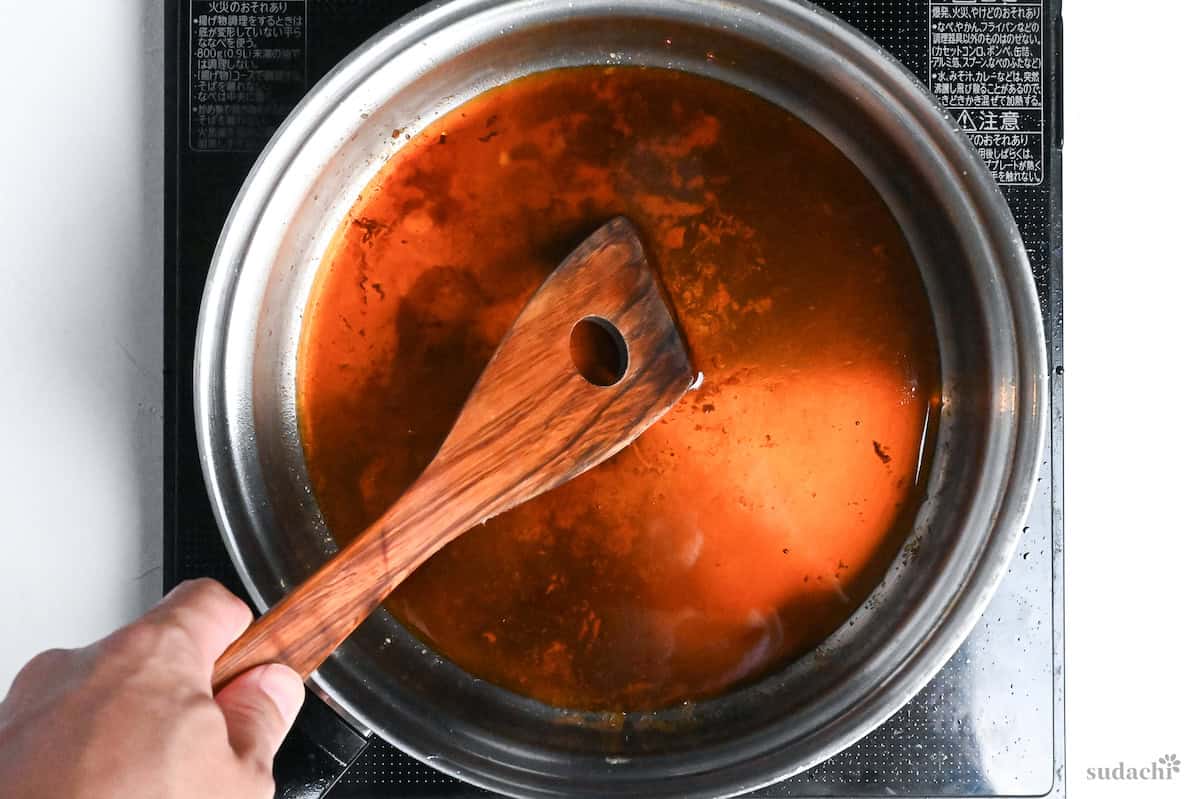
i. Return the pan to high heat and bring the sauce to a brisk simmer for 60 seconds.
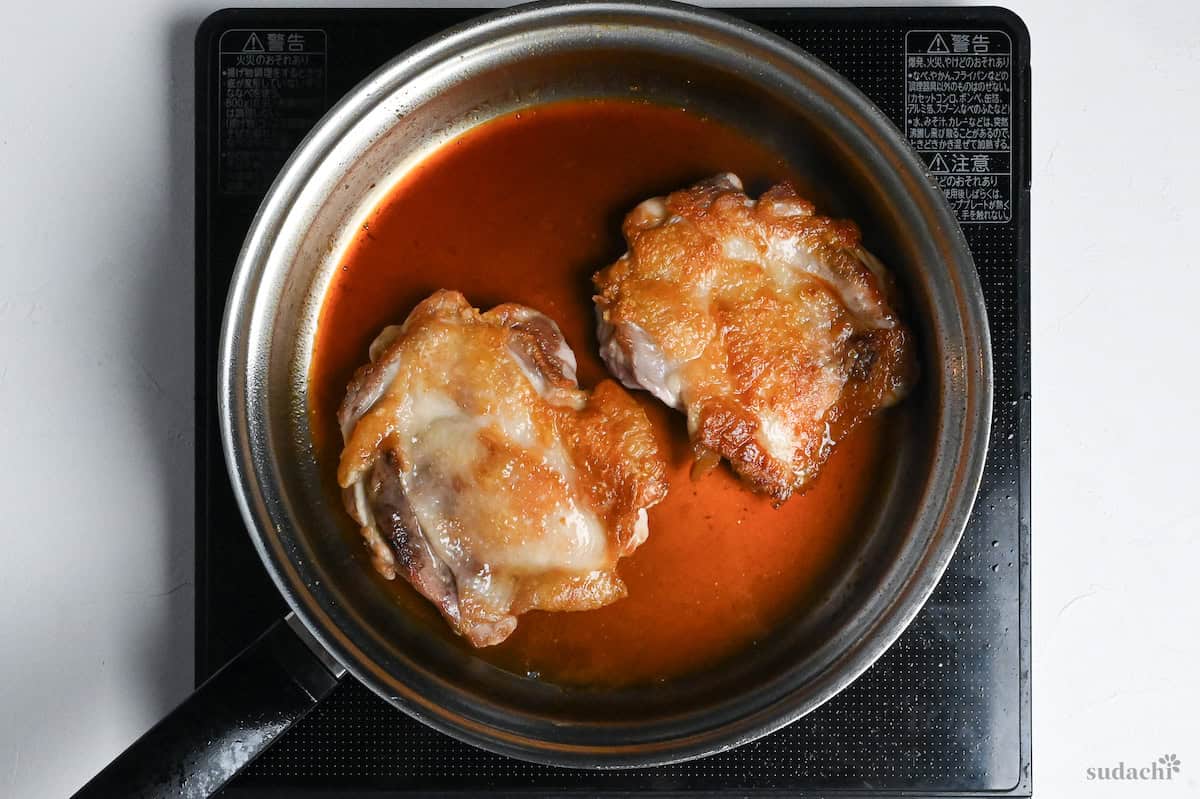
ii. For the classic method, nestle the chicken back in skin-side up and baste constantly until the sauce thickens enough to coat the back of a spoon, about 30-60 seconds more.
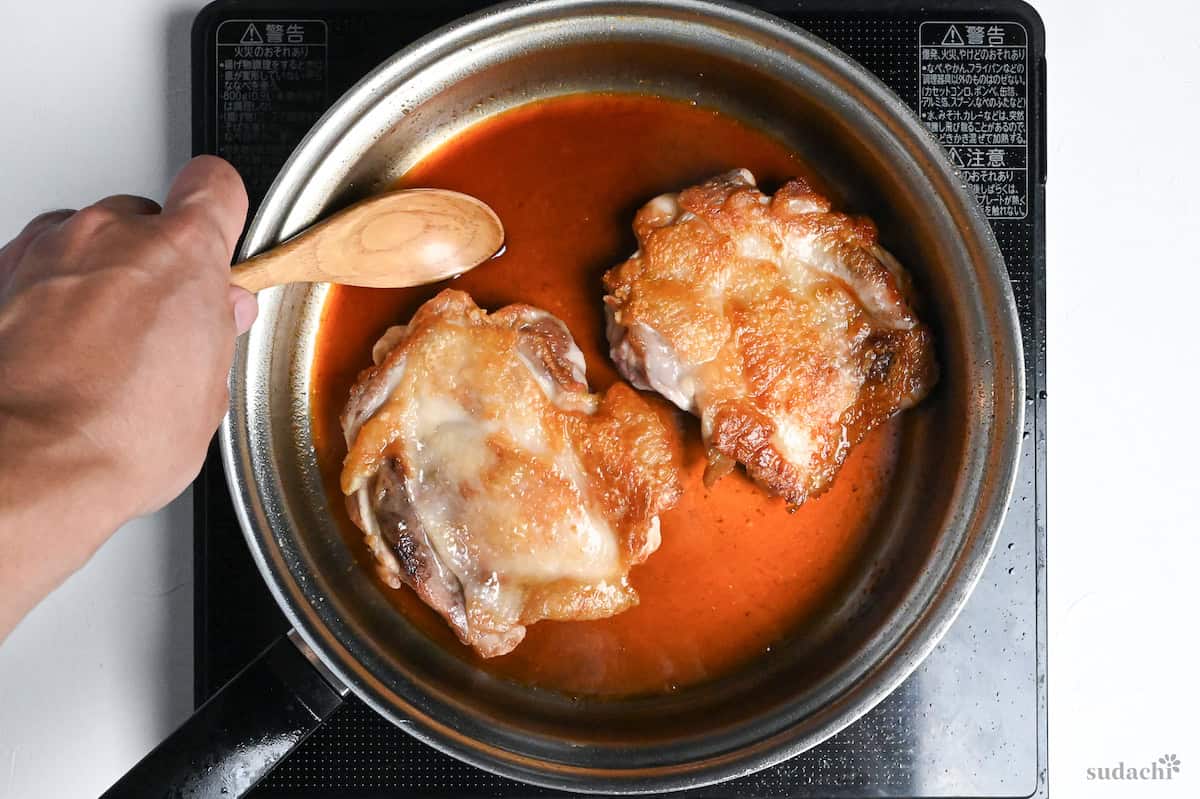
ii (e). For the extra-crispy version, we leave the skin alone and move the chicken around the pan without flipping until the glaze has thickened so that it coats only underneath.
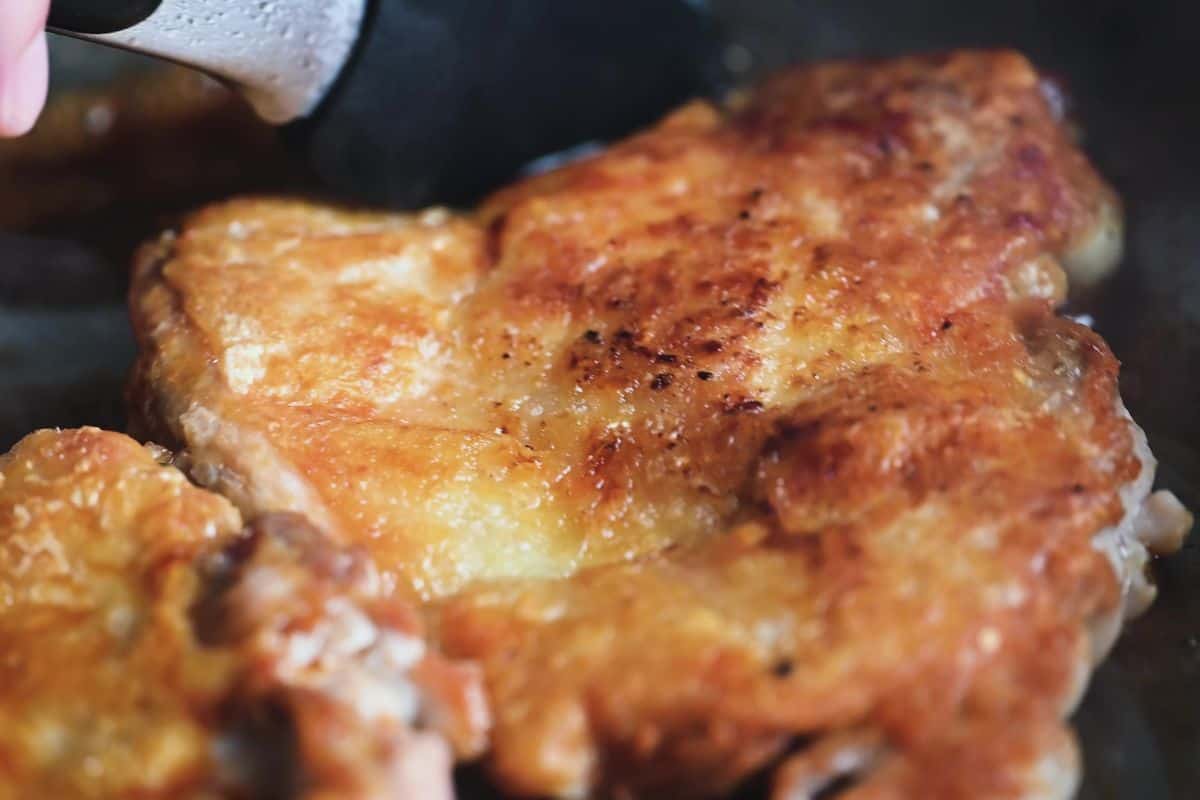
iii. Turn off the heat to avoid over-reduction.

iv. If it’s still thin, pull the chicken out and reduce the sauce a bit longer. If it’s getting too syrupy, add a splash of water or sake.
i. Transfer the chicken to a cutting board skin-side up and rest 3 minutes so juices redistribute.
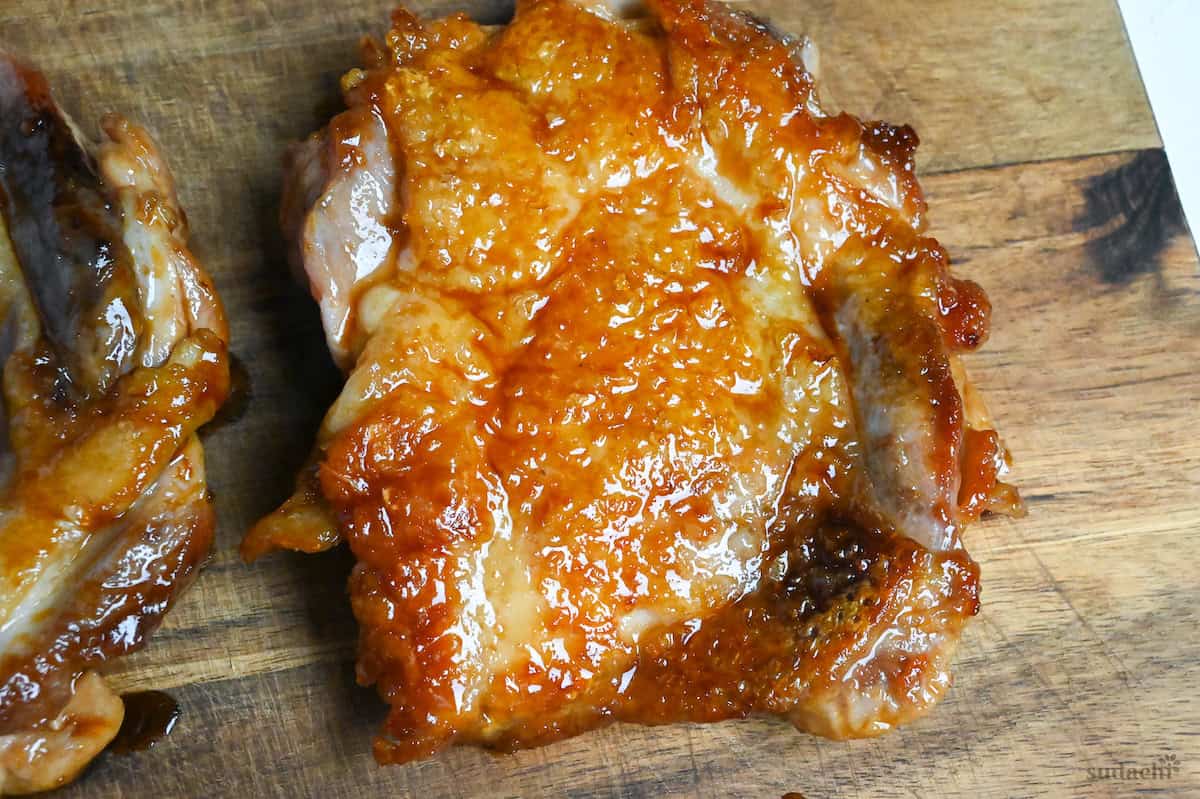
ii. Slice time! It’s easier skin-side down, but skin-side up preserves crispness. Choose your priority.
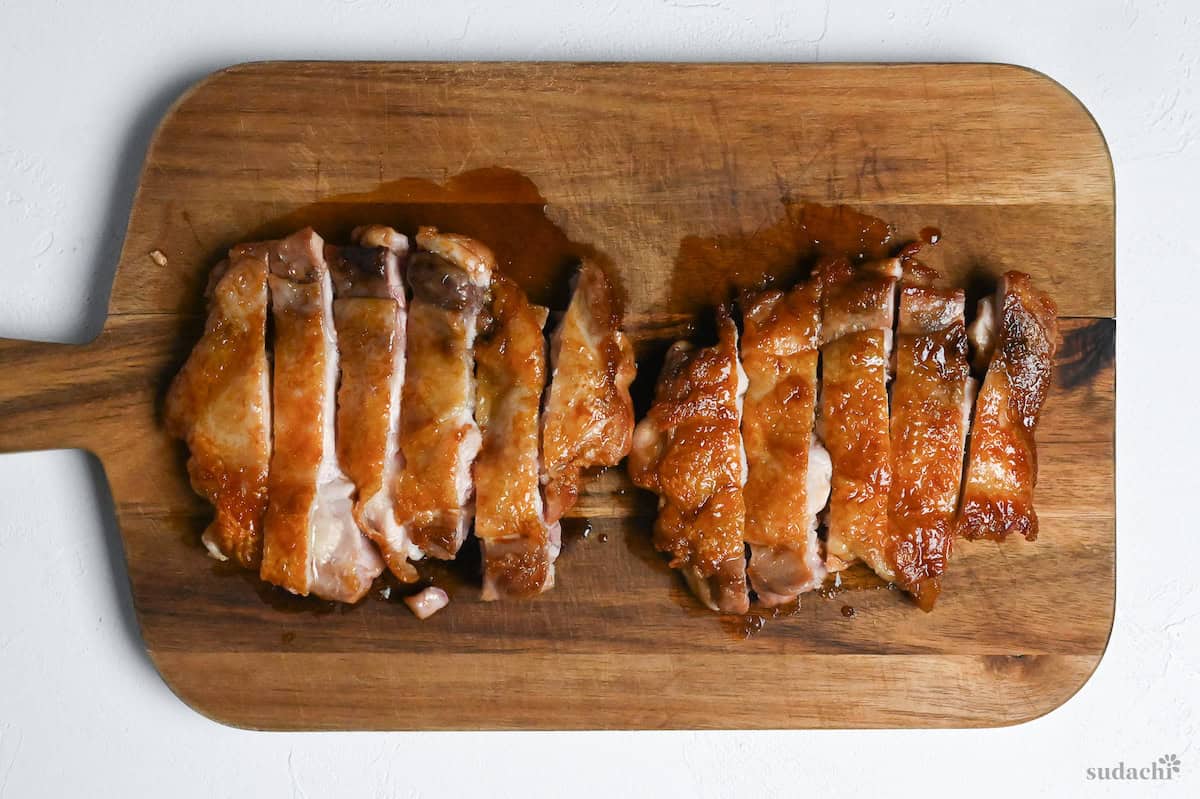
iii. Spoon the remaining glossy glaze in the pan over the surface of the chicken.
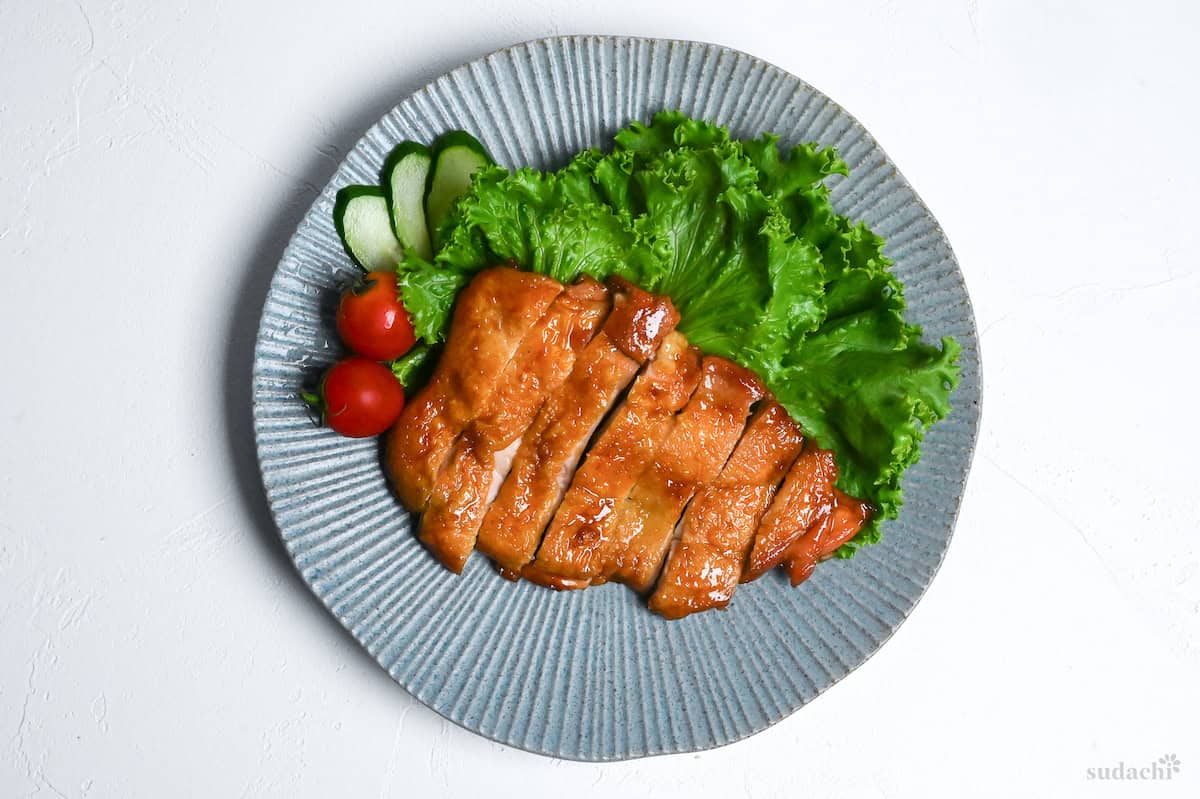
iv. Serve with freshly cooked Japanese rice.
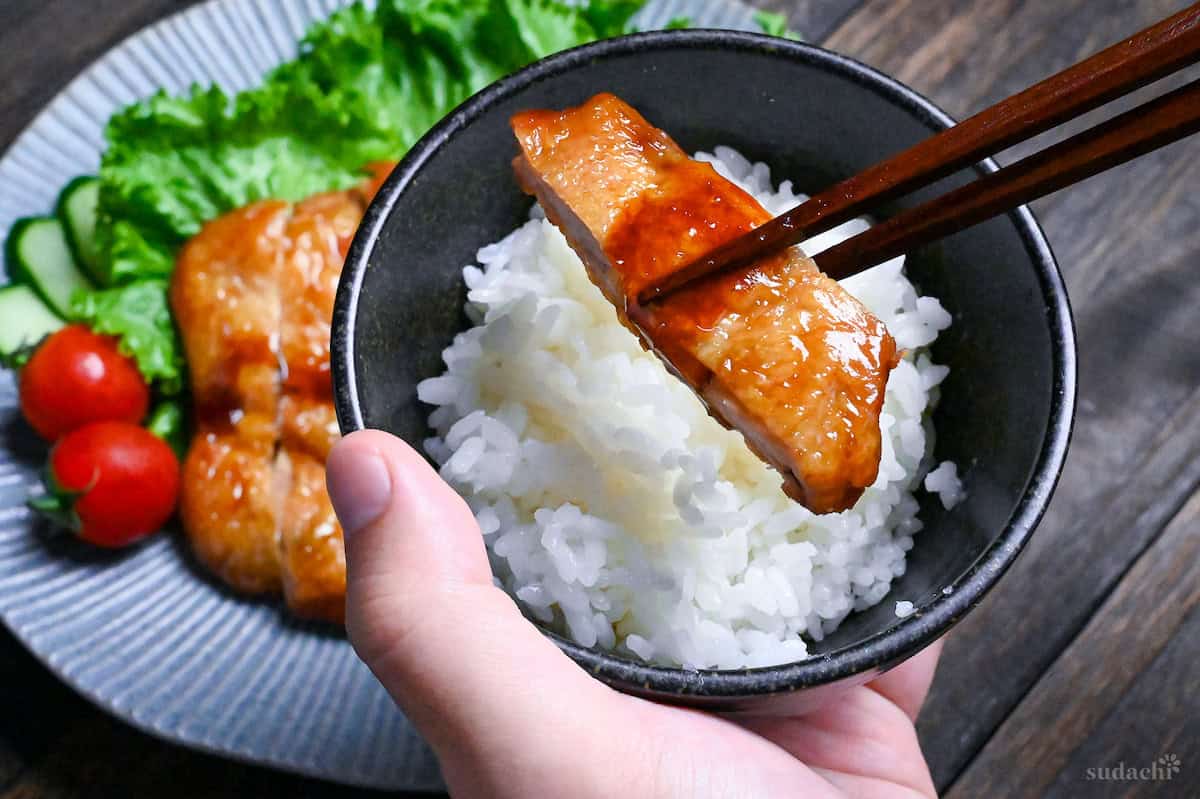
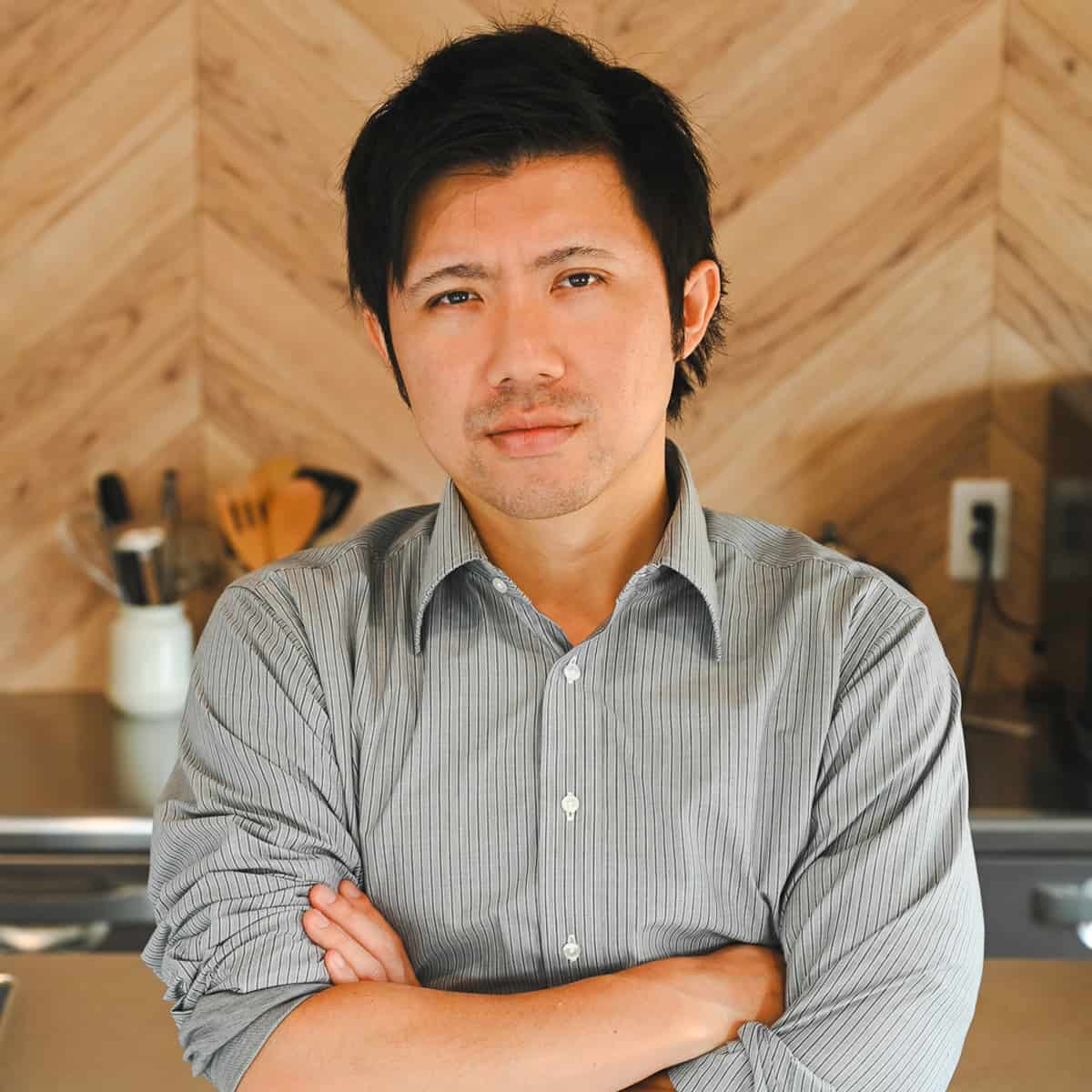
Essential Tips & Tricks
- Always even out the chicken thigh’s thickness before cooking so it cooks through without dry edges or raw spots.
- Drain off excess chicken fat before adding the sauce so the glaze clings instead of turning greasy.
- Always check the thickest part reaches at least 74℃ (165°F) for safe doneness.
- If the sauce isn’t thick enough, remove the chicken from the pan and continue to simmer until it reaches your desired consistency.
- If the sauce gets too thick, add a splash or water or sake (a little at a time) and mix thoroughly to loosen it up.
With these simple tips in mind, you’re set for success every time you make Japanese teriyaki chicken.
Storage & Meal Prep
Fridge: Store cooled chicken in an airtight container for 2-3 days. Keep in mind that the glaze will solidify and the skin will lose its crispness.
Freezer: Freeze portions in airtight containers or freezer bags for up to 2-3 weeks.
Meal Prep: Cook rice, mix the sauce, prepare the chicken (cutting, piercing, and drying) up to 24 hours ahead and store covered in the refrigerator.
Reheating: Reheat thawed or chilled chicken in a skillet over medium heat until piping hot throughout, spooning any leftover glaze over to refresh shine. An oven or air fryer works too.
What to Serve With This Recipe
Teriyaki Chicken Q&A
The heat was too high or the sauce was added too early. Reduce the heat if it looks like it’s scorching. You can always pull the pan off the heat and let residual heat finish the glazing too. If it does burn, rescue the chicken immediately, deglaze the pan with water, and make fresh sauce in a separate pot.
Always remove excess rendered fat from the pan before adding sauce, leave only about 1 teaspoon. If it’s already greasy, serve with acidic sides like pickled vegetables or add a squeeze of lemon juice to cut through the richness.
Absolutely! This isn’t a traditional method, but it’s definitely foolproof. You can keep the chicken skin crispy too. Just cook the sauce without the chicken and brush or spoon it over the hot chicken.
You can use Shaoxing wine instead of sake, but keep in mind that their flavors are quite different. I’d suggest using half the amount of Shaoxing at first. Another option is to use dry white wine or dry sherry!
Yes, if you can’t get all these ingredients or don’t want to use alcoholic condiments, check out my Easy Mock Teriyaki Without Using Sake and Mirin recipe!
I realize using pre-made teriyaki sauce or marinade to make teriyaki chicken outside Japan is common. Don’t get me wrong, there’s nothing wrong with it. However, the authentic way does not use pre-made sauce or marinade because teriyaki is not considered a sauce but a cooking method. The four vital ingredients in the “teriyaki method” are soy sauce, sake, mirin, and sugar.
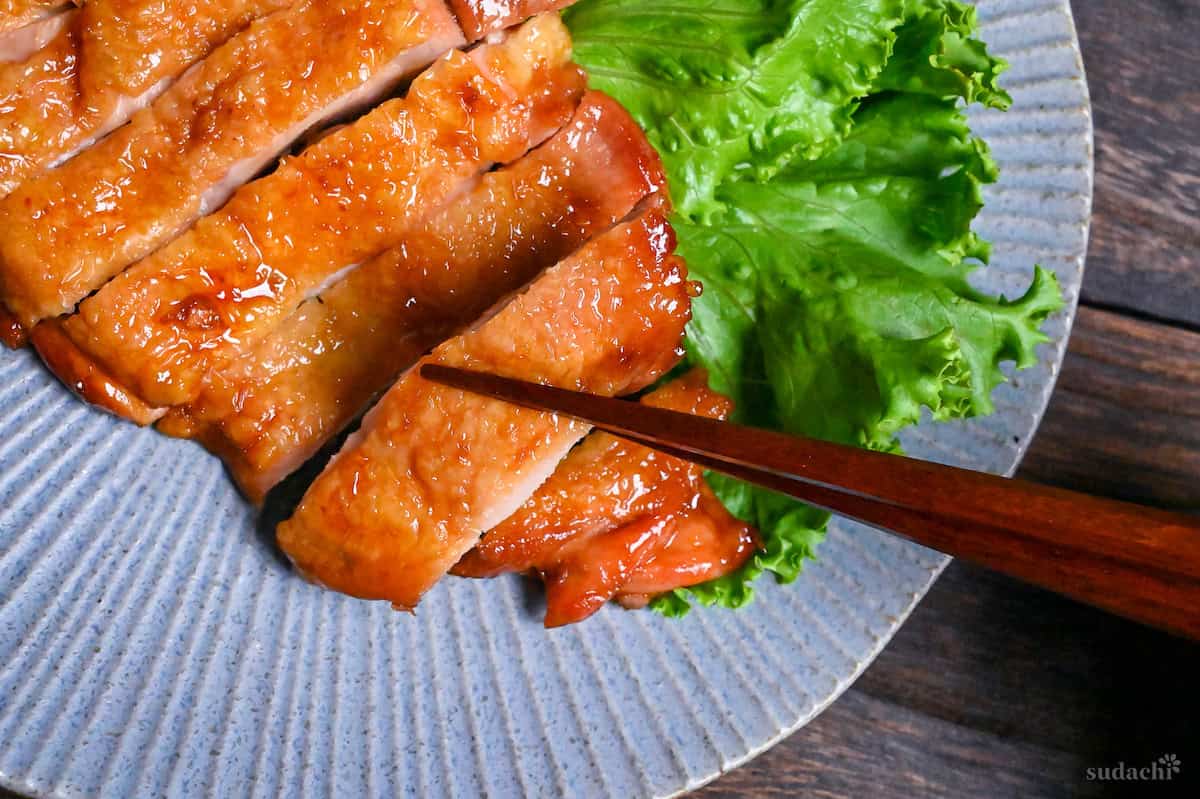
More Delicious Teriyaki Recipes
- Pork Chop Teriyaki with Lemon
- Teriyaki Beef Rice Bowl with Wasabi Twist
- Quick and Easy Teriyaki Cod
- Teriyaki Tofu Donburi
Craving more Japanese flavors? Check out these easy teriyaki recipes that are perfect for busy weeknight meals!
Did You Try This Recipe?
I would love to hear your thoughts!
💬 Leave a review and ⭐️ rating in the comments below. 📷 I also love to see your photos – submit them here!
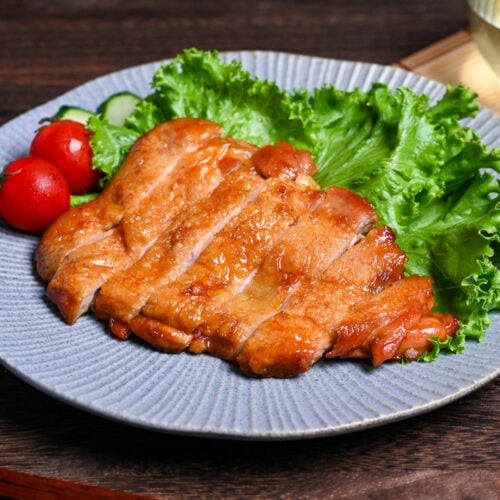
Crispy Teriyaki Chicken (Authentic Japanese Method)
Ingredients
- 450 g boneless chicken thigh skin-on, roughly two whole thighs, can be up to 600g if your pan is big enough
- 4 pinches salt 1 pinch for each side
- ½ tbsp potato starch (katakuriko) or cornstarch
- ½ tbsp cooking oil
- 1½ tbsp Japanese soy sauce (koikuchi shoyu)
- 1 ½ tbsp mirin
- 1 ½ tbsp sake
- 1 tsp light brown sugar or regular sugar
- 1 ½ tbsp dashi stock or water with a pinch of dashi granules
- ½ tsp honey
My recommended brands of ingredients and seasonings can be found in my Japanese pantry guide.
Can’t find certain Japanese ingredients? See my substitution guide here.
Instructions
- Place 450 g boneless chicken thigh on a cutting board with the flesh-side facing up, make horizontal incisions on the thickest parts and open them so that the meat is an even thickness all over.

- Flip the chicken and pierce the skin all over with a fork. Sprinkle with 4 pinches salt on each side and rub until evenly covered.

- Pat the surface dry with kitchen paper. For the traditional method, thinly dust the underneath with ½ tbsp potato starch (katakuriko), brushing off any excess. For the extra crispy method, dust the skin with starch instead.

- Thoroughly preheat the pan on medium, add a generous splash of oil and swirl until evenly coated. Place the chicken with the skin-side down and fry for 7 minutes.

- For the crispy method, cover the chicken with foil and weigh down with a heatproof, flat-bottomed object, like a pan filled with water.

- While you wait, take a small bowl and add 1½ tbsp Japanese soy sauce (koikuchi shoyu), 1 ½ tbsp mirin, 1 ½ tbsp sake, 1 tsp light brown sugar, 1 ½ tbsp dashi stock and ½ tsp honey. Mix until the sugar and honey have dissolved.

- Flip the chicken and fry for 2 minutes on the other side.

- Briefly transfer the chicken to a plate. Carefully pour the rendered fat into a heatproof container and save it for another recipe. Leave about 1 tbsp worth of fat in the pan, and use kitchen paper to wipe excess if needed.Turn off the heat and pour the teriyaki sauce mixture into the pan, scraping any bits of fond off the bottom with a wooden spatula.

- Turn on the heat once more, this time to medium-high. Let it bubble for about 60 seconds, than place the chicken back in the pan with the skin side facing up.

- Baste with the sauce for 30-60 seconds, or until it reaches a syrup-like consistency that clings to the surface of the chicken.If you want to preserve the crispy skin, skip the basting and just move the chicken around the pan until the underneath has a glossy coat.

- Remove from the heat and rest for 3 minutes to allow juices to redistribute before cutting into strips. Plate up and pour any leftover glaze over the top. Enjoy!

Video






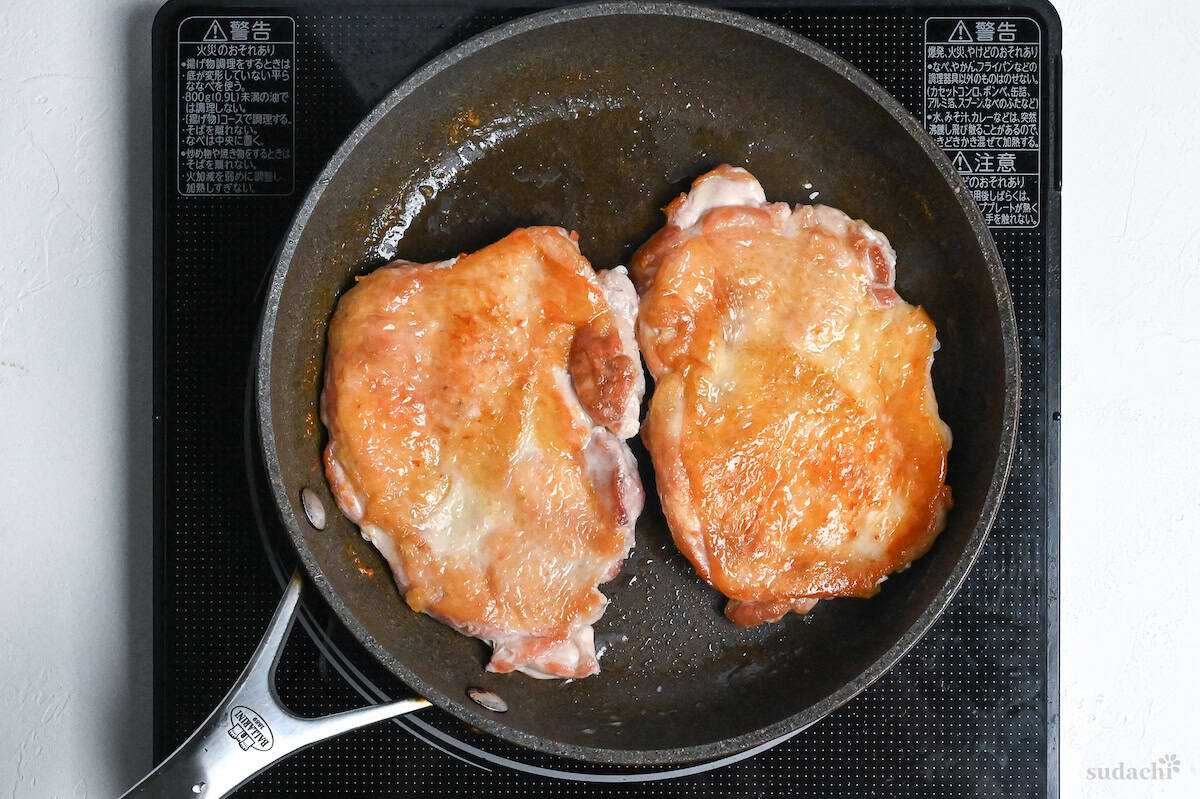
Love the recipe but I don’t have access to mirin, sake, or dashi any suggestions on substitutes?
Thank you! Dashi is just a bonus ingredient that can be replaced with water. To replace sake and mirin, most people recommend dry sherry or rice wine vinegar with extra sugar (maybe an extra tsp for this recipe?) but I haven’t tried it myself so I can’t guarantee the taste. Good luck!
for the mirin and the sake I have used sherry wine (sake) and muscat (mirin) un many recipes with good results.. for the dashi, if you can’t even order it online, maybe u can use dried shitake mushrooms water, it’ll give u the unami taste….
This recipe taught me to cook chicken in a way I had never thought to do before. I have cooked chicken this way using a long list of variations in sauces/marinades. Our favorites include this teriyaki version, as well as BBQ (Korean BBQ) and my own take on a Lemon (and orange!) marinade. Anything you can really think of cooks up perfectly and is really good over rice!
Hi Amy!
I’m so happy to hear you’ve enjoyed this recipe in so many ways, Korean BBQ and lemon chicken sound delicious. I should definitely try that, thank you for sharing!
All the best,
Yuto
Finally, the perfect teriyaki recipe! It’s AUTHENTIC, simple teriyaki without any extraneous ingredients and with the perfect ratio. It’s absolutely delicious! Thank you so much, we’ve made this many times now and love it.
Hi Laura,
Thank you very much for your compliment and making this recipe many times! 🙂
Even though your recipe for the teriyaki sauce has less sugar than most of the traditional recipes I’ve come across, I still find it too sweet. My only conclusion is that the Japanese palate gravitates towards sweet dishes. Will tweak the recipe to my taste. Thanks for sharing!
Hi Diane,
Thank you for the comment!
I think you’re right! When I returned to Japan from England after being away for 5 years, even I found some dishes a bit intense, which I had never thought about before.
I’ve been back in Japan for about 8 years now, but I will keep that in mind and try to adjust the dishes that I feel might be too intense for people outside of Japan, while still maintaining authenticity!
Yuto
Thank you for this recipe! I made it after school for my parents and they loved it! The sauce is hands down the best I’ve ever had.
Hi Lev,
Thank you for trying this recipe and sharing your experience! I’m very happy to hear you and your parents enjoyed it! 🙂
Yuto
What is yoyur recommended sides with this dish
A bowl of freshly cooked Japanese white rice (https://sudachirecipes.com/perfect-japanese-rice/) paired with a light, crisp salad makes an excellent meal. For more satisfying spread, you can add a bowl of miso soup (https://sudachirecipes.com/homemade-miso-soup/) too!
Yuto
hey this recipe sounds and looks so good that we decided to make it for our cooking test and it was amazing thanks for the recipe.
hey this recipe sounds and looks so good that we decided to make it for our cooking test and it was amazing thanks for the recipe.
Hi Arshan,
Thank you so much for trying this recipe and I’m even happier it turned out amazing for your cooking test! 🙂
Yuto
Thank you so much!
Your site is my favorite now!
Thank you so much, Nikol! I’m happy to hear that you’re enjoying my recipes! 🙂
Tried this super easy recipe and loved it! The only thing being I slightly scorched the chicken skin with too high heat, a lesson learnt, but still absolutely delicious
Hi Peter,
Thank you so much for trying my teriyaki chicken recipe! I’m happy to hear that you found it easy and enjoyed it! 🙂
Yuto